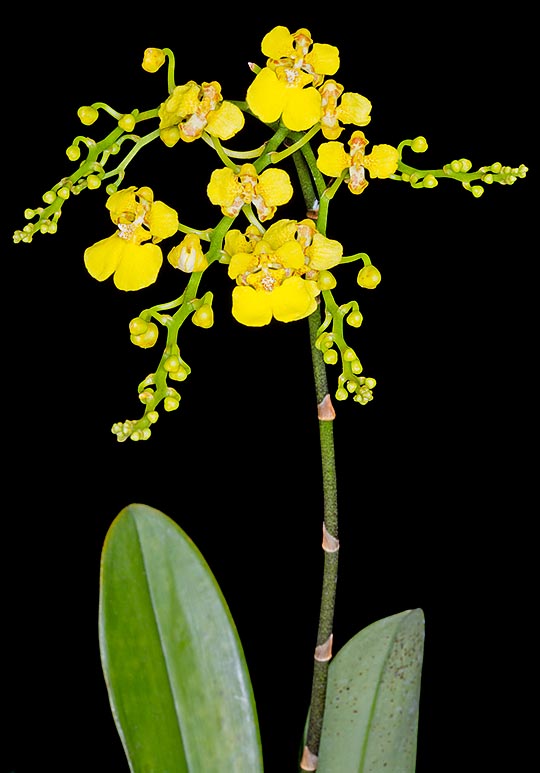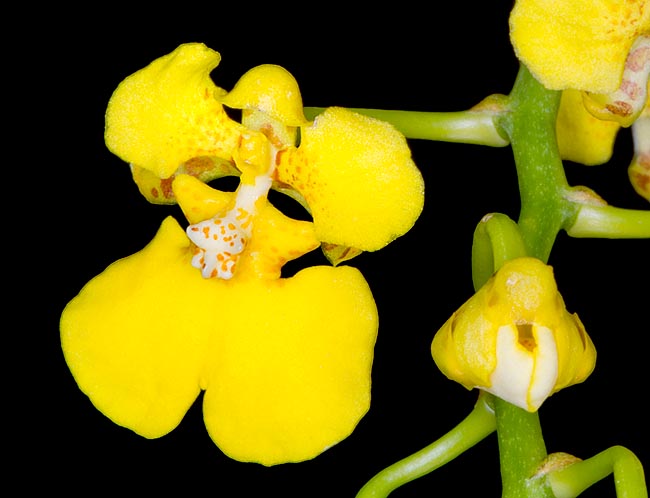Family : Orchidaceae

Text © Pietro Puccio

English translation by Mario Beltramini

Native to Central America, Rossioglossum ampliatum is well known in cultivation © G. Mazza
The name of the genus is the combination of the name of the English collector of orchids John Ross and of the Greek substantive “γλῶσσα” (glossa) = tongue; the name of the species is the Latin adjective “ampliatus, a, um” = expanded, enlarged, with reference to the labellum.
Common names: turtle orchid, turtle shell orchid, yellow bee (English); la tortuga, lluvia de oro (Spanish).
The Rossioglossum ampliatum (Lindl.) M.W.Chase & N.H.Williams (2008) is an epiphytic species with pseudobulbs, on short rhizome, orbicular, laterally compressed, and ribbed, up to 10 cm long and 8 cm broad, of dark green colour dotted of brown red, with at the apex 1-2 oblong-lanceolate leaves with rounded apex, up to about 30 cm long and 7 cm broad, coriaceous, thick, of green colour.
Racemose or panicle inflorescences, erect or arcuate, up to about 1 m long, bearing numerous flowers, of about 2-2,5 cm of diameter, with concave obovate sepals, 0,6 cm long and 0,4 cm broad, of yellow colour with brown red spots, spatulate petals, 0,7-1,1 cm long and 0,6-1 cm broad, yellow with slight brown spots close to the base, flattened trilobed labellum, 1,5-2,5 cm long, with lateral lobes of about 0,3 cm of length and breadth and ample median lobe and trilobed at the apex, 1,8-3 cm broad, of bright yellow colour with a crest at the base of cream colour dotted of red brown.
It seems that the flowers, devoid of oil or nectar, are pollinated by bees misled by the shape and colour of the flowers which simulate those of some Malpighiaceae rich of oil.
It reproduces by seed, in vitro, and division, to be done at the vegetative restart, with each section provided of at least 4-5 pseudobulbs.
Species standing among the most popular of the genus due to the showy inflorescence with bright long-lasting flowers, and the facility of cultivation, requires high luminosity, also some hours of direct sun, medium-high temperatures, 18-32 °C, and high ambient humidity, 60-80%; essential is a good and constant ventilation. The waterings must be regular and abundant during the growth period, to be done in the morning, in order to allow the plants to dry up before evening, and avoiding stagnations between the growing leaves, cause of rottenness, almost suspended in winter, but without letting the pseudobulbs to wrinkle excessively.

The inflorescences reach the metre. The flowers, even 25 mm broad, last 3-4 weeks © Giuseppe Mazza
It can be mounted on bark, trunks rafts of cork or of arborescent ferns roots, or cultivated in pot, preferably in clay, with particularly draining and aerated compost to allow the roots to dry up quickly, being easily subject to rottenness by stagnating humidity, that can be formed by medium sliced fragments of bark and pieces of charcoal, with possible addition of inerts for a better drainage.
The repottings are to be done at the vegetative restart, when necessary.
The species is reported in the appendix II of the CITES (species whose trade is ruled internationally).
Synonyms: Oncidium ampliatum Lindl. (1833); Oncidium gyrobulbon Rchb.f. (1869); Oncidium ampliatum var. majus Lindl. (1894); Oncidium bernoullianum Kraenzl. (1922); Chelyorchis ampliata (Lindl.) Dressler & N.H.Williams (2000).
→ For general notions about ORCHIDACEAE please click here.
